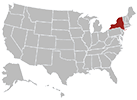
A Medical Assistant (MA) in New York typically trains for more than one certificate.
For instance, they may have a phlebotomy (blood drawing) and an EKG machine reading certificate.
Page Navigation
- Licensing Requirements to Become a Medical Assistant in New York
- 5 Medical Assistant Schools in New York
- Salary
- Schools by City
- Frequently Asked Questions
- How much do I have to pay for Medical Assistant schooling in New York?
- What steps should I take to become a Medical Assistant in New York?
- How long does a New York Medical Assistant program take?
- Is there a demand for Medical Assistants?
- Will a Medical Assistant have other career opportunities?
- Who does a Medical Assistant usually work with?
Licensing Requirements to Become a Medical Assistant in New York
The state of New York doesn’t have any specific licensing requirements for Medical Assistants.
However, healthcare centers in the state require that you seek professional certification.
The American Association of Medical Assistants (AAMA), for instance, offers the Certified Medical Assistant (CMA) certificate.
You also could earn the Registered Medical Assistant (RMA) credential offered by the American Medical Technologists (AMT) or the National Healthcareer Association (NHA) Medical Assistant (CCMA).
There is also the National Center for Competency Testing (NCCT), which offers the Medical Assistant credential, including a pharmacology portion.
Most accredited colleges will provide you with training that prepares you to take a national certification exam.
Beware that not all schools partner with the same credentialing body.
5 Medical Assistant Schools in New York
1. The City University of New York (CUNY)

The 328-hour course provided by CUNY provides one of the most comprehensive certification courses available in the state.
You learn the office side of taking care of patients, including greeting them when they come to the door and managing their health records.
Part of this training also includes billing and coding for insurance purposes.
In addition to learning medical office tasks, this Clinical Medical Assistant training also teaches you how to take vital signs and record their results and helps you become used to preparing patients for testing.
You will also experience patient blood draws and become acquainted with other medical machines, such as heart monitoring devices.
2. Austin Medical Assistant Training (AMAT)
The Medical Assistant Training Certification Program runs for three quarters.
This training will prepare you for the CMA exam hosted by AAMA.
What is more, your AMA certificate coursework will introduce you to both the administrative and clinical sides of working in a medical office.
As a result, you will fill the role of a “Flexible Medical Assistant” who can perform duties even if other office workers are not present.
This adds value to your training, which can increase your earnings.
3. The New York School for Medical & Dental Assistants
![]()
You can earn a Medical Assisting AOS Degree in about 16 months.
During your training, you will learn the foundations, such as concepts about the human body, including the make-up of organs, systems, cells, and tissues.
In addition, you will receive instruction on clinical procedures, such as sterilization, emergency, CPR, X-Ray, and immunization processes.
You will also receive practice with taking vital signs, administering first aid and medications, and EKG heart machine reading.
In addition, your instructions will teach you how to draw blood from patients for blood sugar, hemoglobin, and virus or and bacterial disease detection.
Moreover, you will become acquainted with urine testing and how to use computer software that relates to a Medical Assistant position.
4. New Age Training

The Medical Assistant Program offered by New Age Training will develop the skills you need to operate in a clinic, hospital, doctor’s office, or another healthcare setting.
The coursework will prepare you for an NHA, NCCT, or NCCT certificate.
As you progress through this instruction, you will become accustomed to welcoming patients and answering phones.
In addition, you will know how to schedule appointments, complete insurance forms, and use billing software.
In addition, you will practice your phlebotomy (blood drawing) and EKG heart monitor reading skills.
5. Lehman College (City College of New York, CUNY)
![]()
This campus is a part of the CUNY network.
It is in the Bronx rather than in Manhattan, like the other popular CUNY location.
The point is to reach out to as many locations as possible and make them ready for a career in the medical field in as short of time as possible.
This training will prepare you for the NHA CMA certificate.
Medical Assistant Schools in New York – Summary Table
Top 5 Schools in New York
| School Name | Address |
|---|---|
| The City University of New York | 205 E 42nd St, New York, NY 10017 |
| Austin Medical Assistant Training | 70-10 Austin St #101, Forest Hills, NY 11375 |
| The New York School for Medical & Dental Assistants | 33-10 Queens Blvd, Queens, NY 11101 |
| New Age Training | 145 W 30th St 8th floor, New York, NY 10001 |
| Lehman College (City College of New York, CUNY) | 250 Bedford Park Blvd W, The Bronx, NY 10468 |
Salary
A Medical Assistant in New York, NY can make an average yearly income of $45,611 as reported on May 27, 2022.
The salaries range from $42,052 to $49,251, and you can increase that salary to $52,565 or more.
Cities, where you can find a job in NY, include all the bureaus of New York City and New Rochelle, Albany, Flushing, Yonkers, and West Babylon.
Annual Salary Range:Average Salary of Medical Assistants in New York
| City Name | Salary |
|---|---|
| New York | $45,611 |
| Buffalo | $36,258 |
| Rochester | $37,375 |
| Yonkers | $43,702 |
| Syracuse | $37,370 |
| Albany | $38,361 |
| New Rochelle | $43,521 |
| Mount Vernon | $43,683 |
| Schenectady | $38,382 |
| Utica | $36,307 |
Regional Salary in New York
| Region | Employed | Avg. Annual Salary | Avg. Hourly Pay | Top 10% Annual Salary | Bottom 10% Annual Salary |
|---|---|---|---|---|---|
| Albany-Schenectady-Troy, NY | 1,380 | $41,970 | $20.18 | $47,860 | $36,410 |
| Binghamton, NY | 440 | $40,190 | $19.32 | $46,580 | $34,970 |
| Buffalo-Cheektowaga-Niagara Falls, NY | 2,180 | $42,930 | $20.64 | $52,760 | $35,190 |
| Elmira, NY | 170 | $39,910 | $19.19 | $43,090 | $36,310 |
| Glens Falls, NY | 200 | $42,200 | $20.29 | $47,960 | $37,020 |
| Ithaca, NY | 210 | $46,660 | $22.43 | $50,400 | $36,520 |
| Kingston, NY | 110 | $42,340 | $20.36 | $50,000 | $34,720 |
| New York-Newark-Jersey City, NY-NJ-PA | 45,350 | $47,780 | $22.97 | $57,580 | $36,650 |
| Rochester, NY | 1,640 | $42,790 | $20.57 | $50,600 | $36,500 |
| Syracuse, NY | 1,130 | $42,290 | $20.33 | $50,770 | $36,020 |
| Utica-Rome, NY | 290 | $41,750 | $20.07 | $53,240 | $35,650 |
| Watertown-Fort Drum, NY | ** | $38,410 | $18.47 | $46,460 | $29,540 |
* Employment conditions in your area may vary.
 Schools by City
Schools by City
Frequently Asked Questions
How much do I have to pay for Medical Assistant schooling in New York?
Some certificate programs might only cost you about $3,000-$5,000.
Degree programs might run you about $10,000 or more per year.
Workforce-based training may cost you less than this, but there is usually financial aid for accredited college training.
What steps should I take to become a Medical Assistant in New York?
Make sure you find training that prepares you to take a CMA or equivalent exam.
Your training should also cover clinical, administrative, or both types of CMA duties you would perform in a healthcare setting.
How long does a New York Medical Assistant program take?
You can complete a New York certificate program in about a year.
If you enroll in an associate degree program, your training will take about two years to complete.
Some programs will allow you to start your on-the-job practice in about four to six weeks, however.
Is there a demand for Medical Assistants?
For the entire nation, including New York, the need for someone in this profession may grow by 18%.
A total of 104,400 openings may occur each year until 2030.
Will a Medical Assistant have other career opportunities?
Medical Assistants often move on to become Licensed Practical or Registered Nurse, Sonography technicians, or Medical Office managers.
Who does a Medical Assistant usually work with?
They usually work with nurses, doctors, and other assistants in any professional medical setting that needs someone to greet patients, draw blood or take vital signs.





